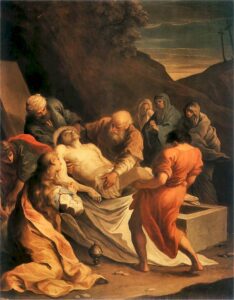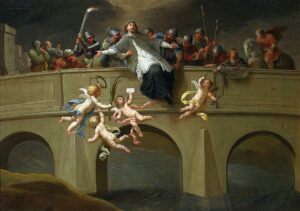Politics and culture go their own ways. Fragmented Italy, plunged into feuds, gave the world the Renaissance. Spain suffered defeat after defeat in the 17th century, but was in its golden age in the field of literature and art. At the end of the reign of Jan III Sobieski, the Polish-Lithuanian state fell into utter apathy, but then a painter was born with a level of talent previously unknown in the Polish-Lithuanian Commonwealth.
by Wiesław Chełminiak
Szymon Czechowicz, educated in Rome, then the artistic center of Europe, created a model of religious art that lasted longer than Polish independence. He was famous and appreciated during his lifetime. He was forgotten when the evaluation criteria changed and critics began to prefer patriotic and socially engaged art. Czechowicz – a zealous Catholic working for the orders and princes of the Church, was not welcomed by the communists either. A month ago, the first ever monographic exhibition of Czechowicz was opened at the National Museum in Krakow. However, due to the COVID-19 epidemic it was shut down quickly.

In the land of meekness
Master Czechowicz’s oeuvre is characterized by exceptional stylistic consistency. It is difficult to distinguish between works from his youth and later ones. Until the end of his life, he remained faithful to Roman patterns, returning many times to these motifs and compositional patterns. He painted on canvas and sheet metal, he was skillful with color, light and detail. He was no stranger to bold perspective shortcuts. When others more or less successfully copied engravings imported from Western Europe, he could rely on his own invention.
Unfortunately, Czechowicz’s oeuvre was largely destroyed (almost all of his Warsaw works burned during the 1944 uprising) and dispersed. Works that have survived are in poor condition, others have suffered from repainting or amateur conservation. In Polish museums, one can admire only single paintings by Czechowicz. The rest is in church altars and in the recesses of monasteries and abroad. Also, the artist himself did a lot to make the task more difficult for future researchers – he usually did not sign and date his works.
Czechowicz’s style is theatrical, but less dynamic and dramatic than Caravaggio’s. He was closer to Raphael, the patron saint of artists who embellished reality and glorified the beauty of the world. In the painting at the end of the 17th and the beginning of the 18th centuries, chiaroscuro and violent gestures went out of fashion, the light became diffused and gentle. This reflected changes in religiosity, the era of the Baroque was coming to an end, the time of frivolous Rococo was coming. Pastel colors, lyricism and elegance counted. Critics, tireless in labeling artists, coined the term “Arcadian classicism” for the art of Carlo Maratta (the alleged master of Czechowicz) and his followers.

Twenty years spent on the Tiber made this son of a Krakow goldsmith into a Roman. Like Maratta, he took viewers to the land of reflection and gentleness. His characters move in a dignified manner, as if they were dancing (art historian Mariusz Karpowicz wrote about “the gentle steps of a minuet”). Unlike Raphael, Szymon Czechowicz lived to an old age. He was exceptionally prolific and left behind about a thousand paintings. They decorated the interiors of such famous churches as St. Mary’s Church in Krakow, the Wawel Cathedral, the Jesuit Church in Poznań and many houses of prayer in the capitals of the Polish-Lithuanian Commonwealth: Warsaw and Vilnius. A record number of Czechowicz’s canvases (140) could be found in the castle in Podhorce which today is located on the territory of Ukraine.
Between Leszczyński and Saxon
Although Czechowicz specialized in religious themes, he did not only paint saints and bishops. Respecting the Polish tradition of realism, he portrayed the secular elite without flattery. Some magnates wanted to please the nobility and pass for patriots, so they paraded in national costumes and grew a mustache. Others, posing as worldly men, ordered him to capture them in a Parisian wig and with a smoothly shaven face.
Szymon Czechowicz took into account the wishes of his clients, but he was a good psychologist too. He was able to reflect the intelligence, temperament and strong character of the model, or their lack thereof. An example of this is the image of Michał Massalski and Jakub Narzymski – collectors of positions for whom their own welfare was more important than the fate of their homeland. Czechowicz created the most beautiful female portraits of the epoch, depicting Katarzyna Jabłonowska, the second wife of the Podlasie magnate Franciszek Maksymilian Ossoliński, who was also the mistress of the ephemeral king Stanisław Leszczyński. He also painted self-portraits, which was an absolute novelty in Poland. The artist’s Achilles’ heel was architecture, he placed the buildings in the far plane, in a fog and barely sketched.

Little is known about the private life of the best painter of the declining Polish-Lithuanian Commonwealth. In his youth, he came under the wings of the aforementioned Franciszek Maksymilian Ossoliński. When Ossoliński realized that the musician from the court band also displayed other talents, he paid for his trip and study in the Eternal City. Such careers were possible, though rarely. For example, Tadeusz Kuntze, a painter a generation younger than Czechowicz, started out as a cook for the bishop of Krakow who funded him a scholarship in Rome, which would prove to be an introduction to a great international career.
In 1716, Czechowicz was awarded in the competition of students of the prestigious Academy of St. Luke. He joined an association of artists called Virtuosi, operating at the Pantheon. The work he was doing for Italian clients is still waiting to be identified. His ties to the country are better documented. In the Polish church in Rome called San Stanislao dei Polacchi, there is still a masterpiece painting “Saint Jadwiga at the Cross”. In 1730, Czechowicz painted “The Assumption of Mary” for the collegiate church in Kielce. Soon after, he returned to his homeland.
He found the country in a deplorable condition. After decades of murderous struggles with neighbors and civil wars, the Polish-Lithuanian state was paralyzed by the dispute between the supporters of the Wettin dynasty and Stanisław Leszczyński, who dreamed of returning to the throne. In 1733, there was a turning point – some nobility chose Leszczyński as the new king, and some the Saxon. The former was supported militarily by France, the latter by Russia, which was closer.
The church hierarchy supported the Wettins, who converted from Lutheranism to Catholicism to win the Polish crown. Leszczyński’s most ardent supporters, including the Ossoliński family, emigrated. In the Commonwealth, now a Russian protectorate, there was peace. It had its advantages – the reconstruction could begin. New churches, monasteries, palaces and manors were built. The artists were busy. Czechowicz settled in Warsaw in the ‘Pod Fortuną’ house on the Old Town Square. He later founded the first private painting school in the history of Poland. His life seemed to be calm and stable. Competition was weak. The graduate of Saint Luke’s Academy was separated from guild painters and artistically gifted monks, which was reflected in the fees paid to him.

The Secret of the Green Room
Master Szymon never worked for King Augustus III, who resided in Saxony on a daily basis. In Poland, the best customers were the magnates who “passed” Czechowicz from “hand to hand”. He became the court painter of the Tarłów, Sanguszko, Sapieha and Hetman Jan Klemens Branicki, whose palace in Białystok was called the “Versailles of Podlasie”. He spent five years in Podhorce – the residence of Wacław Rzewuski. The senator even bought preliminary, reduced versions of his portraits and 70 of them decorated the so-called Green Room, which was the office and bedroom of the castle. Were it not for the Russians who kidnapped the opposition magnate and took him to Kaluga, he would probably have squeezed the artist’s last juices. Today, the Green Room – one of a kind private gallery of Czechowicz’s works, can be seen only in old photographs.
Among the patrons of Czechowicz was the influential Krakow bishop Jan Aleksander Lipski, elevated to the dignity of a cardinal. It certainly made it easier to get church orders. Czechowicz decorated the interiors of monasteries and Catholic churches in Mazovia, Podlasie, Lithuania, Ruthenia and Wielkopolska. Thus he was constantly on the move. Fortunately, the painter was in good health: when he reached his eighties, he set off to Połock, 700 kilometers from Warsaw, invited by the local Jesuits. A journey on the “trail of Czechowicz’s paintings” would be an ambitious task even for an experienced tramp.
He himself, judging from his self-portraits, was a man of common appearance and inconspicuous. Apparently he had a speech impediment so severe that it was hard to understand what he was saying. He earned a lot, but lived modestly, employed only two servants. Pious and extremely hardworking, he never had a family. It took him at least a month to paint a large painting. The demand was so great that he had to hire helpers. Łukasz Smuglewicz is considered to be the most outstanding of them, he married the master’s niece, which gave rise to an artistic dynasty.

Sabers and brushes
Czechowicz died in 1775. In a timely coincidence, at the same time a fresco by Ermenegildo Costantini was created on the vault of Palazzo Borghese which was considered to be “the last glimpse of the Roman baroque”. The master probably bequeathed his accumulated fortune to the Church or donated it to charity. He was a Capuchin tertiary and was buried in the crypt of the Teutonic Church of the Transfiguration on Miodowa Street, one of the most important churches in Warsaw. It was founded by Jan III Sobieski as a votive offering for the victories in the battles with the Turks at Chocim and Vienna. This is where the king’s body originally rested, and his heart remains to this day. There were paintings by Czechowicz on the main altar. Unfortunately, in the fall of 1944 they were burnt down together with the entire interior by the Germans.
However, Czechowicz left a legion of disciples and followers. The colorful world of the Baroque Polish-Lithuanian Commonwealth was preserved in their paintings. Its neighbors wiped it off the political map of Europe, but it still existed in faith, culture and custom. “We all have Czechowicz’s works ‘in front of our eyes’. Entering Polish churches and even looking at contemporary paintings depicting the Mother of God with Child – we can see that Czechowicz introduced a pattern of perception of religious painting into our aesthetics,” emphasizes Monika Tarnowska-Reszczyńska, an art conservator.

Master Szymon will be remembered as an accomplice for yet another breakthrough. During his life, painting was not treated as a craft in Poland. It was considered to be one of the liberal arts, which was confirmed, among others, by the resolutions of the Jagiellonian University in Krakow and the Lwów city council. In the latter city, members of the guild of Saint Luke were ennobled, which gave them the right to wear sabers and full political rights reserved for the nobility.
Poland’s artistic ties with Rome did not end. At the end of Czechowicz’s life, Marcello Bacciarelli, born and educated in the papal capital, settled in Warsaw. The position of a royal painter was only the beginning of his career there. But that’s a completely different story.
Author: Wiesław Chełminiak
Translation: Alicja Rose & Jessica Sirotin
The exhibition “The Genius of the Baroque. Szymon Czechowicz 1689–1775” in the Main Building of the National Museum in Krakow 16 October 2020 – 28 March 2021.




